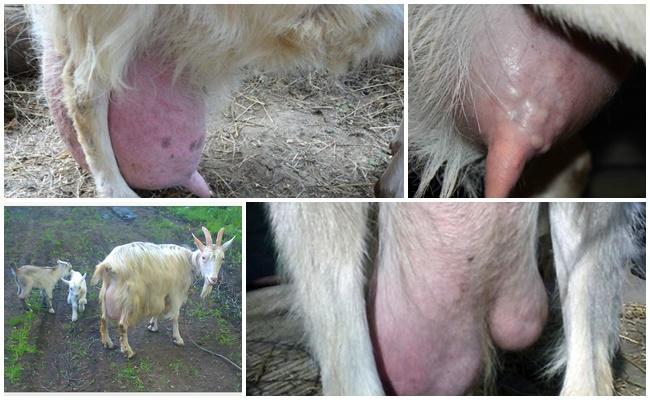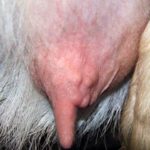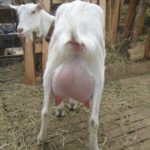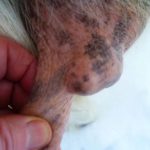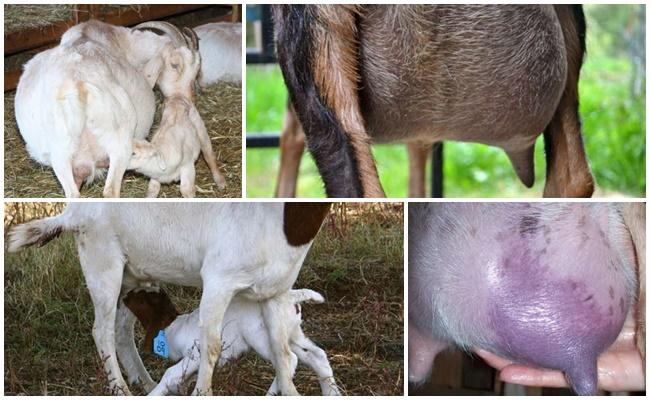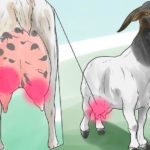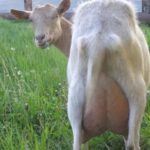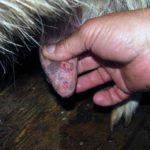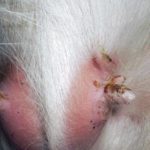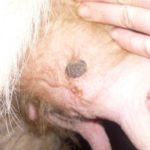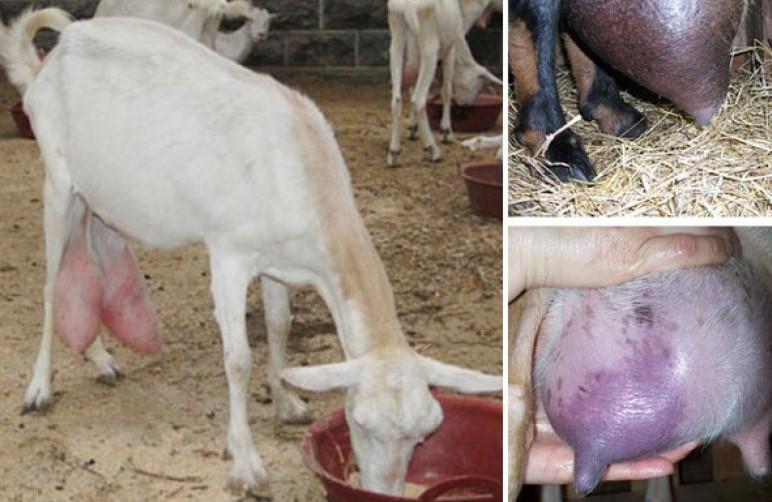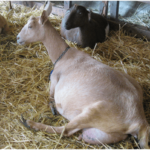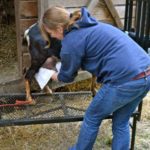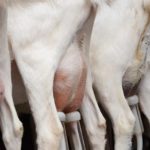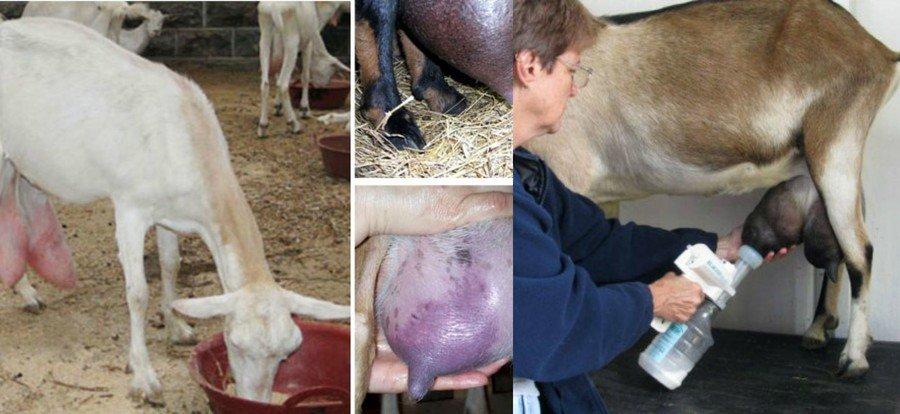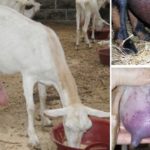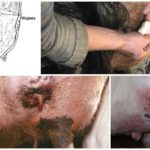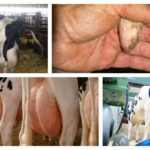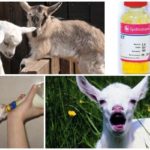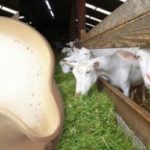Goats have a fairly strong immune system; they rarely get sick, but their most sensitive organ is the udder. Goat teats harden and become painful when they are affected by infectious and non-infectious pathologies caused by illiterate care and maintenance of animals. Also, the reasons why a goat has hard lumps in its udder are injuries. The farmer must find out the cause of the pathology in order to begin proper treatment.
The structure of the udder in goats and lactation
To find out the cause of the compaction, you need to know how it works goat udderHow does lactation occur? The udder includes:
- connective tissue that gives the organ its shape;
- mammary gland;
- excretory ducts;
- drives;
- nipple canal
Goats have a pair of mammary glands, “packed” into a skin pouch. The udder is divided into two parts. Each part synthesizes milk separately from the second. Nipples are composed of muscle tissue covered by several layers of skin. At the end there is a sphincter - a ring-shaped muscle that prevents the spontaneous flow of milk. Milk synthesis occurs in the alveoli - bubbles with a diameter of 0.1-0.3 mm. Their inner surface is covered with secretory tissue. The cells of this tissue take vitamins, minerals, and nutrients from the blood, which are converted into casein and milk fat.
Pressure increases in the alveoli filled with secretions. Milk is squeezed into ducts, from which it flows into storage tanks. From there it penetrates into the nipple canal. When the kid sucks the mother or when milking occurs, the sphincter opens and milk flows out.
Possible causes of udder compaction
The udder is a delicate and sensitive organ of the goat, susceptible to many diseases. A healthy udder is symmetrical, without ulcers, knots or lumps, and the nipples are elastic. With pathologies, the milking organ becomes deformed and takes on an unattractive appearance. The amount of milk decreases and its taste deteriorates.
The most common pathological lumps in the goat udder are:
- bumps (cystic and tumor formations);
- mastitis;
- furunculosis;
- swelling;
- injuries (open and closed wounds, bruises, cracks).
Cones
Older goats are susceptible to the appearance of benign and malignant tumors, since the hormonal levels in their body change, and subsequently the structure of the udder tissue. Benign cysts and malignant tumors look like lumps. However, other lump-shaped compactions should be distinguished from tumors:
- milk stones - accumulation of phosphorus salts or calcareous hardening of casein in the ducts;
- petrification - saturation of abscesses with mineral salts.
The reasons for the appearance of milk stones are an inflammatory reaction in the udder or stagnation of milk. The seals are mobile, are usually found in glandular storage areas, and come out in the form of grains of sand with milk. Crystallized boils form in small numbers and are always preceded by the appearance of a purulent rash.
Tumor formations are dense to the touch and cause pain and discomfort to the animal. Unlike milk stones, they are immobile. As the tumor grows, ulcers often appear on the surface of the body. Cysts are blisters filled with liquid contents. When they appear, glandular tissue gradually turns into connective tissue.
Mastitis
Goat udders often become inflamed. Lumps are especially common in pregnant and postpartum goats, whose immunity is temporarily reduced. Less commonly, mastitis is a consequence of unsuitable living conditions for animals:
- dampness;
- draft;
- cold;
- unsanitary conditions.
Mastitis may occur due to incomplete milking. If the milk is not milked completely, it stagnates in the alveoli, causing inflammation.
A goat with mastitis is nervous because the lump in the udder is painful. The disease is accompanied by severe symptoms:
- swelling;
- compaction of the organ;
- hot when feeling the skin of the udder;
- lethargic state of the animal;
- increased temperature;
- swelling of the lymph nodes;
- lack of appetite in the goat;
- the release of foul-smelling milk of a watery consistency with lumps.
If a goat that has given birth has swollen lymph nodes, but there are no other symptoms, then there is no need to worry. This is the body's reaction to the birth process.
Injury
Sometimes lumps in the udder are a consequence of injury. Young male goats are lively and playful and can injure the mother’s udder. Therefore, you should not keep a goat with cubs. When a bruise occurs, lumps under the skin are bruises that look like bluish sores. The goat is in pain, the skin of the udder becomes hot, and there are blood inclusions in the milked milk.
Edema
A swollen udder swells greatly. Causes of the pathological condition:
- impaired blood circulation;
- sedentary lifestyle of the animal;
- poor quality diet.
Usually the swelling disappears a week after it appears. If not, you should call a veterinarian. Veterinary attention is also required if the swelling increases, the nipples become cold, and the milk becomes watery.
Furunculosis
The purulent inflammatory process affects the sebaceous glands and hair follicles. Goats with dense hair covering the udder and weak immunity are predisposed to inflammation.
But the main provocateur of seals is illiterate care of the animal: poor hygiene in the barn, infrequent change of bedding.
Boils are small pimples with a diameter of 0.5 cm, gradually enlarging to 4-5 cm. They cover the nipples, the base of the organ, and the depression between the lobes. The rash is painful, the skin is irritated, red, and swollen.
After ripening, the boils rupture and pus flows out. Sometimes papules appear - nodular compactions filled not with pus, but with connective tissue.With extensive furunculosis, the goat resists milking because it experiences severe pain.
Wounds
When a goat's tit is mechanically injured, a laceration is formed. The animal is injured while walking in thorny bushes, among heaps of solid garbage or metal fragments. Lacerated wounds heal slowly, but deeply penetrating and closed injuries are much more dangerous. The latter look like black spots in appearance. The skin swells, becomes inflamed, and ulcers form inside.
Cracked nipples
Goats' teats crack due to mechanical stress, poor care, the development of a bacterial disease or hypovitaminosis. The cracks are painful, the animal resists milking.
Treatment methods
Having identified pathological lumps in the goat's udder, you need to immediately provide first aid, and then call a veterinarian to make a diagnosis. A sick animal requires careful care, feeding with high-quality succulent feed and concentrates, and keeping in a clean, dry and comfortable barn. Each udder pathology requires a specific method of therapy.
Mastitis in goats cannot be treated with ointments and hot compresses, because of this the disease becomes chronic. The animal is given tetracycline antibiotics, injections are placed in the udder after milking. The seal is treated with Lysol or Creolin.
If inflammation is caused by pathogenic bacteria, then bactericidal external agents are used. There should always be clean, warm water in the goat's drinking bowl.
Furunculosis is treated as follows:
- The fur is shaved off the udder.
- The skin is treated with manganese or other antiseptic solution.
- Unbroken pimples are lubricated with iodine tincture (opened boils cannot be lubricated).
- To accelerate the maturation of acne and tighten breaks, use ichthyol ointment or “Syntomycin”.
- Large boils are opened by making a crosswise incision.
Antibiotics are not required for furunculosis. Applying hot compresses to the seal is strictly prohibited.
The wound is treated as follows:
- They give an injection of novocaine.
- Clean the wound. Remove dead tissue and purulent exudate.
- Treat the injured area with manganese solution or hydrogen peroxide.
- The purulent wound is partially sutured, leaving a hole for the exudate to escape.
- Treat with antiseptic ointment or powder, for example, streptocide.
- The animal is given a systemic antibiotic.
- When the purulent discharge stops, clean the edges of the wound and apply a suture.
If there is a bruise, apply a cold compress. An intravenous injection of calcium gluconate is given to increase blood clotting. 3-4 days after the injury, the seal is lubricated with iodine or ichthyol ointment. The bruise usually lasts no more than 10 days.
In order for the swelling to subside, the goat is often walked and fed properly. For cracked nipples, streptocide, ichthyol ointment, and balsamic liniment are used. It is prohibited to use iodine tincture and other aggressive substances.
There is no treatment for tumor lumps. Surgical removal of tumors is possible, but this is not economically feasible on farms. Therefore, the sick goat is slaughtered.
Possible consequences
With most of these pathologies, serious consequences do not occur. With proper treatment, the animal quickly returns to normal. The only dangers are mastitis and furunculosis. In the acute form of mastitis, ulcerative and necrotic processes begin in the tissues. The milk becomes purulent and smells rotten. A goat that does not receive timely treatment dies.
Advanced furunculosis affects the entire udder, which complicates treatment.If the goat has a weak immune system, then the disease can develop into phlegmon - an acute inflammatory process with the accumulation of pus in the subcutaneous fatty tissue, which has a vague border, spreading to adjacent tissues.
Disease Prevention
You need to check the goat's udder daily before milking. If suspicious symptoms are detected, you should immediately call a veterinarian.
Goat udder care includes 3 procedures:
- The washing up. The udder is wiped with a towel moistened with warm water and wiped dry.
- Lubricating with baby cream or vegetable oil. The procedure is carried out after milking, as well as on cold days. When pimples and cracks appear, antibiotic ointment is used.
- Massage before milking. With hands lubricated with cream, first gently knead, then pat both lobes of the udder.
The farmer should have potassium permanganate, iodine, hydrogen peroxide, and ointments for disinfection and wound healing on hand to help the animal if necessary. It is necessary to maintain cleanliness and order in the barn, regularly change the bedding, and prevent drafts and low temperatures.

